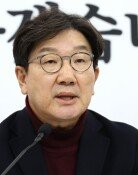Korea’s economy expected to grow1.6percent next year
Korea’s economy expected to grow1.6percent next year
Posted December. 22, 2022 07:45,
Updated December. 22, 2022 07:45
The Ministry of Economy and Finance made a new year’s report to President Yoon Suk Yeol with an outlook that next year’s economy will grow by 1.6 percent and exports volume will drop by 4.5 percent year-on-year. In line with the figures in the report, new employment next year is expected to plunge by 90 percent compared to this year. This means the impact of the global economic recession would pose a substantive threat to Korea’s economy in the new year.
The prospect of a low growth rate of 1.6 percent is all the more worrisome given that the ministry’s outlook reflects the administration’s willingness in terms of policy direction. The numbers can get even worse if unexpected situations, such as an additional U.S. rate hike, China's economic slowdown, and prolonged war in Ukraine, take place. Growth in the 1 percent range is the lowest except during extreme economic crises, including with the second oil shock in the 1980s, 1998 and 2009, right after the Asian Financial Crisis and global financial crisis, respectively, as well as in 2020 when Covid-19 hit the world.
It is very rare that an administration expects a significant drop in exports even before the start of the new year. Factors that will undercut exports are lining up, including sharp contraction in the semiconductor industry, which accounts for one-fifth of Korea’s exports. While the government predicts that the trade balance, which suffered the largest deficit this year, would turn over to positive, this is also expected to be a “recession-type surplus,” caused by a dramatic decline in imports of crude oil and raw materials compared to exports volume.
Two days before the ministry’s report, the government and the ruling People Power Party presented ‘40K dollars per capita income in 2027’ as a macroeconomic goal after their party-government consultations. It aims to achieve the 40K-dollar goal in the last year of the Yoon administration by promoting five major reform tasks: labor, pension, education, finance, and service. The problem, however, is that the per capita income has been declining right from this year. Per capita GDP, which was 34,984 dollars in 2021, is expected to slide by 4 percent to 33,590 dollars this year due to the weak Korean Won. To achieve the target of 40K dollars in 2027, the number should grow by 4 percent for five years in a row, but Korea's potential growth is lagging behind at around 2 percent.
Previous administrations under former Presidents Lee Myung-bak and Park Geun-hye also set a goal of per capita income of 40K dollars. Yet, what is more important than the goal itself is specific plans to attain the goal and the government's willingness to execute the plan. The government must speed up regulatory and tax reforms on top of the five major reforms to boost growth potential. Above all, the urgent priority is to overcome the unprecedented, complex global crisis that has already become a reality.
Headline News
- Joint investigation headquarters asks Yoon to appear at the investigation office
- KDIC colonel: Cable ties and hoods to control NEC staff were prepared
- Results of real estate development diverged by accessibility to Gangnam
- New budget proposal reflecting Trump’s demand rejected
- Son Heung-min scores winning corner kick







